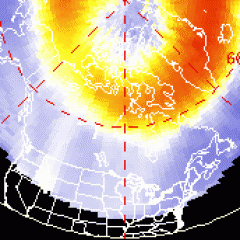With five mag 7+ earthquakes in less than a month, here’s another look at correlations between an active Sun and seismicity here on Earth:

The current auroral oval is bright and lopsided. Image from Spaceweather.
Large earthquakes of magnitude 7 and above have been increasing dramatically since the Haiti quake of 12 January 2010, with three occurring in just the first couple of weeks of 2011. While I don’t believe these large quakes will continue at the current rate, early indications suggest we could be on target to see record numbers as the year progresses.
(Update 18 January 2011: Today’s quake in Pakistan, which again just precedes the incoming solar wind due to arrive on the 19th or 20th, brings us to 4 mag 7+ quakes in 2011, and 6 in less than a month. )
A list of yearly magnitude-7+ earthquakes since the last solar minimum in 1996 can be found in the article More Links Among the Sun, Earthquakes, and Mine Explosions. As predicted in that article, published 17 June, we were on target to see more than 20 quakes in excess of mag 7 by the end of the year. In fact, according to the United States Geological Survey (USGS), 22 mag 7+ quakes were recorded during 2010.
Today’s quake in the Loyalty Islands, variously reported at between mag 7 and 7.3, directly precedes the solar wind that is set to hit Earth in the next day or so. I’ve noted before that that incoming solar wind effects geomagnetic changes, often resulting in earthquakes, when it impacts our planet’s magnetosphere just prior to the wind’s actual arrival on Earth.
Each earthquake is different and may be precipitated by any number of factors aside from solar activity; however, evidence for a causal relationship between the Sun and some seismic activity continues to emerge. Aside from large coronal holes and solar eruptions, other indicators I monitor at the Spaceweather website include: 1) solar wind, which tends toward high speed and low density just before and during many seismically-active days, and 2) the auroral oval, which is often thick and strongly-lopsided on approach of solar wind and CMEs, predicting geomagnetic disturbances.
STACE TUSSEL
NOTE: Depictions of the auroral oval from several key earthquake dates in 2010 are currently missing, for unknown reasons, from the Spaceweather archives.
